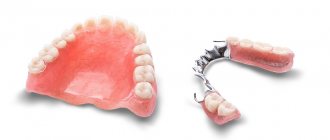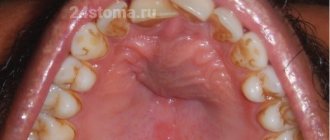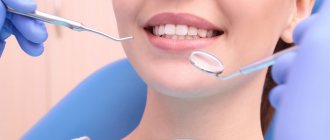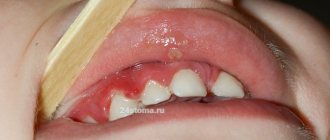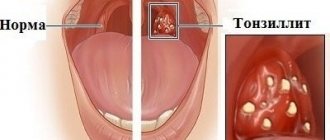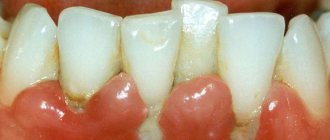The most common form of gingivitis is catarrhal gingivitis, which affects the gums, causing superficial inflammation. Most often, this disease affects children and young people under 35 years of age. In older patients, as a rule, chronic catarrhal gingivitis is diagnosed.
Teeth polishing with pastes - 1,200 rubles.
Polishing one tooth with paste - 50 rubles.
Coating with a fluoride-containing product (1 row of teeth) - RUB 1,500.
Coating with fluorine-containing varnish (1 tooth) - 250 rubles.
Retraction of hypertrophied gums in the area of 1 tooth - 600 rubles.
At CELT you can get advice from a dental specialist.
- The cost of a dental consultation is 1,000
- The cost of an orthodontist consultation is 2,000
Make an appointment
Causes of gingivitis
Gingivitis does not always progress as a separate disease. It often appears in the background:
- Imbalance in the hormonal system.
- Disturbances in the gastrointestinal tract.
- Diseases of the cardiovascular system.
- Infections and inflammatory processes.
Internal factors in the development of pathology are as follows:
- Fall of immunity.
- Growth of wisdom teeth.
- Lack of vitamins P and C.
- Allergy.
- Diabetes.
- Metabolic disorders.
- Chronic gastrointestinal diseases.
- Severe mental disorders.
Among the external causes of gingivitis:
- Smoking or improper breathing.
- Burns and mechanical damage to the mucous membrane.
- Incorrect installation of the seal.
- Irregular brushing of teeth.
- Infections.
In more than 50% of cases, the development of pathology occurs due to pathogens that penetrate the oral cavity with food and liquid. If you brush your teeth incorrectly and irregularly and do not use floss, a thick plaque will appear. Often inflammation begins due to a burn or mechanical damage to the gums. A lack of nutrients in the diet and serious stress can reduce immunity, which will also lead to the development of pathology.
Gingivitis
Gingivitis is an inflammatory process in the gums that occurs under the influence of various factors. A distinctive feature of the disease is the preservation of the integrity of the periodontal junction, that is, the source of inflammation is limited to the soft tissues that are located above the periodontal ligament. In the presence of unfavorable factors, including a decrease in general immune status, it often develops into periodontitis.
Etiology and pathogenesis
The main cause of gingivitis is poor hygiene. Irregular or lack of brushing of teeth leads to the fact that first soft plaque and then hard stone begin to accumulate on their surface, which irritate the gums and cause inflammation.
Aggravating factors include:
- dentoalveolar deformations (bad bite) and bruxism, causing abrasion of teeth, against the background of which gradual destruction of gum tissue occurs;
- smoking, which accelerates the formation of supra- and subgingival deposits and slows down the healing process;
- heredity, genetic predisposition to periodontal tissue diseases;
- pregnancy and other hormonal changes in the body, which lead to increased sensitivity of the gums and make them more vulnerable to bacterial microflora;
- instability of the psycho-emotional background, frequent stress, which reduces resistance and inhibits the functioning of the immune system;
- poor nutrition, unbalanced diet, when there is a lack of vitamins and minerals necessary for oral health;
- drug therapy (oral contraceptives, antidepressants).
Pre-existing diseases of the cardiovascular system, kidneys, and serious endocrine disorders, in particular diabetes mellitus, in which the treatment of any bacterial infection is difficult due to impaired insulin production, can also accelerate the development and aggravate the course of the pathology.
Clinical picture
The main clinical symptoms of gingivitis are bleeding gums, redness and swelling of soft tissues. Their severity depends on the amount and composition of dental plaque, with the prolonged presence of which microbial activity increases and an active pathological process begins with the involvement of interdental papillae and marginal tissues.
Taking into account the clinical symptoms, gingivitis can be:
- catarrhal
- often occurs against the background of past infections and poor oral hygiene, accompanied by tissue hyperemia, itching and soreness, bleeding of the gums during eating or brushing teeth; - ulcerative
- characterized by sharp pain, bad breath (smell of rot), increased salivation, gums bleed heavily, possible fever; often becomes a consequence of ARVI and occurs against the background of chronic stress; - hypertrophic
- may be accompanied by severe swelling (edematous form) or proliferation of fibrous tissue (fibrous form) with bleeding and an unpleasant odor; typical for pregnant women and adolescent patients (puberty).
The disease occurs in acute, chronic or recurrent form, and can be localized (limited) or generalized (spread out).
Diagnosis and treatment
Diagnosis is made by physical examination. If necessary, blood tests (general and biochemical) and ELISA may be prescribed. In addition to probing, the Schiller-Pisarev test, x-rays are performed, and the gingivitis index is determined. If endocrine or digestive disorders are detected, the patient is referred to specialized specialists.
The main goal of treatment is to suppress the inflammatory process and may include antibacterial and keratoplasty drugs, physical therapy. Medical tactics depend on the form of the pathology and the severity of symptoms. Tartar and plaque are removed without fail, and the oral cavity is sanitized.
Prevention
To prevent the development of gingivitis, it is necessary to properly care for your teeth and undergo a professional oral hygiene procedure every six months to control biofilm.
Read more:
- What does a periodontist do?
Symptoms of catarrhal gingivitis
The sooner treatment for acute catarrhal gingivitis begins, the lower the risk of subsequent complications. Symptoms that should promptly contact your dentist include the following:
- bleeding, redness and swelling of the gums;
- itching in the gums;
- increased body temperature;
- bad breath, unpleasant taste;
- pain in the gums when eating or pressing on them;
- general malaise, fatigue.
Indications
You need to immediately begin treatment for catarrhal gingivitis if you find:
- Swelling of the gums.
- Bleeding after eating or brushing teeth.
- Acute pain and burning in the gum area.
- Bad breath.
- Putrid or bloody taste in the mouth.
- Changes in gum color and density.
Contraindications
It is not recommended to start treatment if you have:
- Psychological and nervous diseases.
- Cardiovascular pathologies.
- Problems with blood clotting.
- Chronic diseases in the acute stage.
- Allergic reactions to anesthesia.
A specialist will give you a full list of contraindications during a face-to-face consultation.
Forms of gingivitis: signs and diagnosis
Next, we will examine in more detail the various forms of gingivitis.
Catarrhal gingivitis is often painless. The main symptom is bleeding gums, for example when brushing teeth or biting hard food.
Necrotizing ulcerative gingivitis is the most severe form, accompanied by itching, acute pain, high fever, and the appearance of dead areas of the gums.
Hypertrophic gingivitis is characterized by acute pain, enlarged gums, and continuous bleeding of the gums. Tartar can form in the space between the gum and tooth. Possible slight movement of teeth.
Atrophic gingivitis is the most severe degree of gingivitis and most often precedes periodontitis. At this stage, the necks of the teeth or even the roots are exposed due to severe reduction of the gums. It is also typical to increase the sensitivity of teeth to various irritants, for example, to cold or, conversely, hot food.
Desquamative gingivitis is characterized by the appearance of blisters on the gums, ulcers and cracks. In addition, there is redness on the gums.
Forms of catarrhal gingivitis
Depending on the nature of the lesion, there are:
- acute catarrhal gingivitis - characterized by rapid development and one-time inflammation, limited in time;
- chronic catarrhal gingivitis is a continuation of acute; in the absence of treatment, it is practically asymptomatic, but with regular exacerbations.
The scale of inflammatory processes determines two forms of gingivitis:
- localized - part of the gum is inflamed, no more than 1 - 3 teeth;
- generalized - the entire gum on one or both jaws is inflamed.
The severity of the disease is as follows:
- mild - the periodontal papillae are affected;
- medium - the free area of the gums is affected;
- severe - the alveolar region of the gum is affected.
Diagnosis of the disease
Diagnosis of catarrhal gingivitis involves examination by a doctor and laboratory tests.
The latter allow you to determine indicators such as:
- bleeding gums;
- degree of inflammation;
- amount of microbial plaque.
When conducting an examination, the dentist pays special attention to the following factors:
- how full the blood vessels of the gums are;
- red gums;
- integrity of the periodontal junction;
- the presence and amount of plaque and tartar;
- presence of signs of destruction of the interalveolar septa.
Treatment of the disease
Treatment of chronic catarrhal gingivitis involves a set of measures aimed at eliminating the already emerging consequences of the disease, as well as the causes that caused it. Typically, it begins with a professional teeth cleaning at the dentist's office.
The course of treatment is selected individually and depends on the form, severity and nature of the disease. Often the patient is prescribed mouth rinsing with antiseptic solutions and the oral cavity is sanitized. It involves treating caries, filling teeth, and replacing incorrectly installed fillings. This approach eliminates the possibility of relapse of the disease in the future.
Drug therapy consists of treating the oral cavity with antiseptic solutions and applications of special ointments. When treating the chronic form, it is possible to massage the gums.
It is worth noting that treatment is often carried out in combination with a diet that excludes foods that irritate the gums and is rich in vitamins A, B, E.
Treatment of chronic catarrhal gingivitis of any severity has been successfully carried out by dentists at the CELT clinic for several years now.
Recommendations after treatment
To avoid the occurrence of catarrhal gingivitis after treatment, you need to follow 7 rules:
- Lead a healthy lifestyle and support your immune system. Consume a vitamin-mineral complex and a sufficient amount of proteins, carbohydrates and fats.
- Prevent the transition of chronic diseases to the acute stage. Treat chronic diseases of the cardiovascular and hormonal systems, gastrointestinal tract.
- At least 2 times a year, carry out professional cleaning of the oral cavity to remove soft and hard plaque and prevent the formation of tartar.
- Use a toothbrush with medium hardness. Too soft does not sufficiently clean teeth from plaque, and hard ones can injure the enamel and cause pain with high sensitivity.
- Properly clean the oral cavity and the space between the teeth using floss and irrigator.
- Visit the dentist regularly in order to promptly detect inflammatory processes and eliminate them at an early stage.
- Choose the right toothpaste with sodium, fluoride, potassium nitrogen and other components. Entrust this task to your doctor.
If you follow these recommendations after treatment, you will confidently avoid a recurrence of catarrhal gingivitis.
Make an appointment through the application or by calling +7 +7 We work every day:
- Monday—Friday: 8.00—20.00
- Saturday: 8.00–18.00
- Sunday is a day off
The nearest metro and MCC stations to the clinic:
- Highway of Enthusiasts or Perovo
- Partisan
- Enthusiast Highway
Driving directions
Treatment of gingivitis
According to the American Academy of Periodontology, treatment of periodontal disease should focus on achieving oral health in the least invasive and most cost-effective manner. Your dentist or periodontist will typically start with a non-surgical approach and then re-evaluate the condition at subsequent visits. If infection or deep periodontal pockets remain, surgical treatment may be recommended.
Approaches to treating diseases can be mainly classified as follows:
- Deep cleaning of tartar and bacteria from the gum line and tooth root.
- Removing plaque from teeth. Today ultrasonic cleaning is used. After the procedure, the dentist polishes the teeth with a special paste and brush, and also applies an antiseptic gel to the gums. Often, one visit to the dentist is enough.
- Anti-inflammatory therapy for gingivitis. Removing deposits is sufficient in most cases, but anti-inflammatory therapy is required to bring teeth and gums to the healthiest they can be. In this case, you can use treatment methods at home:
- Antiseptic rinses
- Application of medicinal gels
- Applying toothpastes for inflammation
In addition to treatment at the dentist's office, regular dental visits and cleanings (usually every 3 months) are essential to maintaining good oral hygiene practices at home.
Treatment of gingivitis at home
The ability to treat gingivitis at home is extremely limited. It is possible to prescribe anti-inflammatory drugs, but removal of deposits is impossible (only at the dentist). Remember, at home you can only relieve symptoms, for example, bleeding gums, but this is only for a limited time - soon the disease will recur with renewed vigor. Use gels, ointments, and toothpastes only if you cannot urgently see a dentist. The advertisements do not talk about the reasons behind bleeding gums or the need for tartar treatment at the dentist. The reasons are quite clear.

